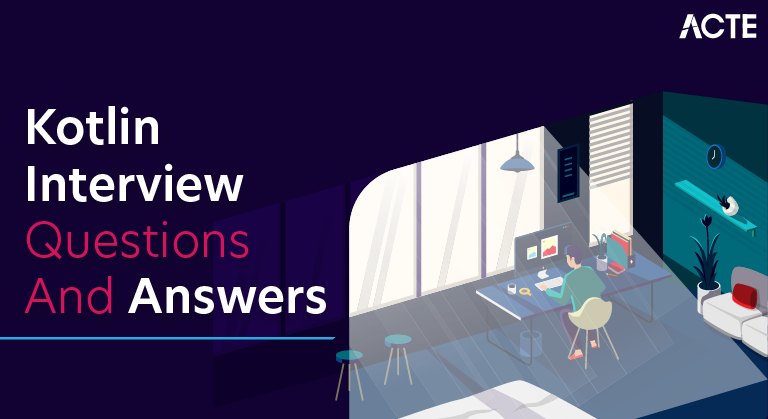
Kotlin is immensely practical. It addresses the problems that developers have, and not some guys in the academia. So, it has type inference, it has amazing type safety, good collection library, and concurrency library to top it. And it’s now official – a lot of organisations are migrating their backend applications to Kotlin, and this trend is not likely to end soon. Follow along to check the most complete and comprehensive collection of the most common and advanced Kotlin Interview Questions every Android developer should know in 2020.
1. What is Kotlin, and how does it differ from Java?
Ans:
Kotlin is a statically-typed programming language developed by JetBrains, designed to be fully interoperable with Java. Unlike Java, Kotlin offers concise syntax, null safety, and extension functions, enhancing code readability. The interoperability allows seamless integration with existing Java codebases.
2. Explain the concept of smart casts in Kotlin.
Ans:
Smart casts in Kotlin automatically cast a variable’s type based on certain conditions, eliminating the need for explicit casting. This feature enhances code clarity and reduces boilerplate code, making Kotlin code more concise and readable.
3. What is the primary purpose of Kotlin Coroutines?
Ans:
Kotlin Coroutines facilitate asynchronous programming by efficiently managing concurrent tasks without blocking threads. They simplify complex asynchronous code, improving performance and responsiveness in applications.
4. How does Kotlin handle null safety, and what are nullable types?
Ans:
Kotlin addresses null pointer exceptions by introducing nullable types. A variable’s type is explicitly marked as nullable using the “?” symbol, ensuring developers handle potential null values explicitly and reducing unexpected crashes.
5. Describe Kotlin’s data classes and their significance.
Ans:
Kotlin’s data classes streamline the creation of classes primarily meant for holding data. They automatically generate useful methods like equals(), hashCode(), and toString(), reducing boilerplate code and enhancing code maintainability.
6. What are sealed classes, and how are they used in Kotlin?
Ans:
Sealed classes restrict the inheritance hierarchy of a class, allowing only a predefined set of subclasses. This feature is valuable for representing restricted class hierarchies in a concise and secure manner.
7. Explain the purpose of the ‘by’ keyword in Kotlin.
Ans:
The ‘by’ keyword in Kotlin is used for delegation. It enables the delegation of property or method implementations to another object, promoting code reuse and maintainability by separating concerns.
8. How does Kotlin handle extension functions, and why are they beneficial?
Ans:
Kotlin supports extension functions, allowing developers to add new functions to existing classes without modifying their source code. This promotes code organization, reusability, and enhances the readability of code.
9. Discuss the use of the ‘lateinit’ modifier in Kotlin.
Ans:
‘lateinit’ in Kotlin allows the declaration of non-null variables without immediate initialization. It is particularly useful when the initialization value is determined at runtime, providing flexibility in certain scenarios.
10. What are Kotlin’s primary collection types, and how do they differ from Java collections?
Ans:
Kotlin introduces immutable collections like List, Set, and Map by default, promoting functional programming practices. This design enhances safety and avoids accidental modifications to collections.
11. Describe Kotlin’s use of ‘when’ as a replacement for Java’s ‘switch’ statement.
Ans:
Kotlin ‘when’ expression is a more powerful and flexible alternative to Java’s ‘switch’ statement. It supports complex conditions, ranges, and exhaustive checks, making it a versatile tool for handling multiple cases in a concise manner.
12. Explain the concept of type aliases in Kotlin.
Ans:
Type aliases in Kotlin allow developers to create alternative names for existing types, improving code readability and providing meaningful abstractions without introducing new classes.
13. What is the purpose of the ‘init’ block in Kotlin?
Ans:
The ‘init’ block in Kotlin is used for initializing code that should be executed when an object of a class is created. It ensures that specific code runs before any other code in the class body, facilitating proper object initialization.
14. Discuss Kotlin’s approach to immutability and its impact on concurrent programming.
Ans:
Kotlin encourages immutability, reducing the likelihood of race conditions in concurrent programming. Immutable data structures and variables simplify the reasoning about program state, leading to more reliable and maintainable concurrent code.
15. What are delegates in Kotlin, and how do they contribute to code reuse?
Ans:
Kotlin encourages immutability, reducing the likelihood of race conditions in concurrent programming. Immutable data structures and variables simplify the reasoning about program state, leading to more reliable and maintainable concurrent code.
16. Explain the ‘let’, ‘apply’, ‘run’, ‘also’, and ‘with’ scope functions in Kotlin.
Ans:
Kotlin encourages immutability, reducing the likelihood of race conditions in concurrent programming. Immutable data structures and variables simplify the reasoning about program state, leading to more reliable and maintainable concurrent code.
17. How does Kotlin handle functional programming concepts, and what are higher-order functions?
Ans:
Kotlin encourages immutability, reducing the likelihood of race conditions in concurrent programming. Immutable data structures and variables simplify the reasoning about program state, leading to more reliable and maintainable concurrent code.
18. Discuss the role of extension properties in Kotlin.
Ans:
Extension properties in Kotlin complement extension functions by enabling the addition of new properties to existing classes. This feature enhances code readability and supports a more natural syntax when working with extended properties.
19. What is the purpose of the ‘reified’ keyword in Kotlin?
Ans:
The ‘reified’ keyword is used in inline functions to retrieve the actual type of a generic parameter at runtime. This enhances type safety and facilitates more robust generic programming in certain scenarios.
20. Explain the significance of the ‘by lazy’ property initialization in Kotlin.
Ans:
The ‘by lazy’ initialization in Kotlin defers the initialization of a property until it is accessed for the first time. This can improve performance by avoiding unnecessary computations or resource allocations until they are needed.
21. How does Kotlin handle default and named parameters in functions?
Ans:
Kotlin supports default parameter values and named parameters in function declarations. This feature enhances code readability and allows developers to provide default values for parameters, reducing the need for overloaded functions.
22. Discuss Kotlin’s approach to handling exceptions and the ‘try’ expression.
Ans:
Kotlin supports default parameter values and named parameters in function declarations. This feature enhances code readability and allows developers to provide default values for parameters, reducing the need for overloaded functions.
23. Explain Kotlin’s use of ‘infix’ functions and their benefits.
Ans:
Kotlin supports default parameter values and named parameters in function declarations. This feature enhances code readability and allows developers to provide default values for parameters, reducing the need for overloaded functions.
24. What are sealed interfaces, and how do they differ from sealed classes in Kotlin?
Ans:
Kotlin supports default parameter values and named parameters in function declarations. This feature enhances code readability and allows developers to provide default values for parameters, reducing the need for overloaded functions.
25. Discuss the role of the ‘runBlocking’ function in Kotlin’s coroutine context.
Ans:
Kotlin supports default parameter values and named parameters in function declarations. This feature enhances code readability and allows developers to provide default values for parameters, reducing the need for overloaded functions.
26. What is Kotlin’s type hierarchy, and how does it differ from Java’s?
Ans:
Kotlin supports default parameter values and named parameters in function declarations. This feature enhances code readability and allows developers to provide default values for parameters, reducing the need for overloaded functions.
27. Can you explain the concept of extension functions in Kotlin?
Ans:
Kotlin supports default parameter values and named parameters in function declarations. This feature enhances code readability and allows developers to provide default values for parameters, reducing the need for overloaded functions.
28. How does Kotlin handle multiple constructors, and what is the role of the ‘constructor’ keyword?
Ans:
Kotlin supports default parameter values and named parameters in function declarations. This feature enhances code readability and allows developers to provide default values for parameters, reducing the need for overloaded functions.
28. How does Kotlin handle multiple constructors, and what is the role of the ‘constructor’ keyword?
Ans:
Kotlin supports default parameter values and named parameters in function declarations. This feature enhances code readability and allows developers to provide default values for parameters, reducing the need for overloaded functions.
30. What are sealed classes, and how do they contribute to the development of robust code in Kotlin?
Ans:
Sealed classes in Kotlin restrict the inheritance hierarchy, allowing only a predefined set of subclasses. This ensures that all possible subclasses are known at compile time, promoting code predictability and maintainability. Sealed classes are often employed when modeling a restricted set of related classes, preventing unexpected extensions and ensuring exhaustive handling of cases.
31. Discuss the role of the ‘when’ expression in Kotlin and provide examples of its usage.
Ans:
The ‘when’ expression in Kotlin serves as a powerful replacement for traditional ‘switch’ statements in other languages. It allows developers to handle multiple conditions and define complex scenarios in a concise manner. For instance, ‘when’ is commonly used in parsing and processing different types or states, providing a more readable and expressive alternative to nested ‘if-else’ structures.
32. Can you elaborate on Kotlin’s approach to handling null values and the use of the safe call operator?
Ans:
Kotlin addresses null pointer exceptions by introducing nullable types and the safe call operator (‘?’). The safe call operator allows developers to safely access properties or methods on potentially null objects without triggering a null pointer exception. This feature enhances code safety and readability, ensuring explicit handling of null values to prevent runtime crashes.
33. Explain the significance of Kotlin’s ‘init’ block in class initialization.
Ans:
The ‘init’ block in Kotlin is used for initializing code that should run when an object of a class is created. It provides a dedicated space for executing code during object initialization, ensuring that specific tasks are completed before other code in the class body. This promotes clean and organized code, facilitating proper object initialization and setup.
34. How does Kotlin handle default parameter values in function declarations, and it’s benefits?
Ans:
Kotlin supports default parameter values in function declarations, allowing developers to specify default values for parameters. This feature improves code readability and reduces the need for overloaded functions with various parameter combinations. Developers can choose to use default values or provide specific values based on the context, enhancing flexibility and conciseness in function calls.
35. Discuss the role of Kotlin’s ‘apply’ scope function in object initialization and configuration.
Ans:
The ‘apply’ scope function in Kotlin facilitates concise object initialization and configuration. It allows developers to execute a block of code on an object within its context, often used for setting properties or performing initialization tasks. This promotes clean and readable code by eliminating the need for additional temporary variables or multiple lines of code to configure an object.
36. How does Kotlin support extension properties, and in what scenarios are they beneficial?
Ans:
Kotlin’s extension properties complement extension functions by enabling the addition of new properties to existing classes. This promotes code readability and supports a more natural syntax when working with extended properties. Extension properties are particularly beneficial when additional properties need to be associated with a class without modifying its original source code, facilitating code organization and modularity.
37. Explain the role of ‘reified’ in inline functions and its impact on generic programming in Kotlin.
Ans:
The ‘reified’ keyword in Kotlin is used in inline functions to retrieve the actual type of a generic parameter at runtime. This enhances type safety and facilitates more robust generic programming by allowing developers to perform type-specific operations within the inline function. ‘Reified’ ensures that type information is available at runtime, enabling more sophisticated and type-safe manipulations compared to non-reified generic parameters.
38. Can you elaborate on the concept of Kotlin Coroutine?
Ans:
Kotlin Coroutines provide a powerful mechanism for asynchronous programming by efficiently managing concurrent tasks without blocking threads. They offer a lightweight and structured approach to writing asynchronous code, improving code readability and maintainability. Coroutines simplify complex asynchronous operations, such as network requests or file I/O, by providing a sequential and natural flow, enhancing the overall responsiveness of applications.
39. Discuss Kotlin’s approach to handling exceptions and the benefits of the ‘try’ expression.
Ans:
Kotlin Coroutines provide a powerful mechanism for asynchronous programming by efficiently managing concurrent tasks without blocking threads. They offer a lightweight and structured approach to writing asynchronous code, improving code readability and maintainability. Coroutines simplify complex asynchronous operations, such as network requests or file I/O, by providing a sequential and natural flow, enhancing the overall responsiveness of applications.
40. Explain the concept of ‘infix’ functions in Kotlin and scenarios where they are useful.
Ans:
The ‘infix’ keyword in Kotlin allows the definition of functions that can be called using infix notation. Infix functions enhance code readability by making certain operations more natural and expressive, especially in DSLs (Domain-Specific Languages) and fluent APIs. For instance, infix functions can be employed to create concise and human-readable syntax when chaining multiple operations together, contributing to a more intuitive and readable codebase.
41. How does Kotlin handle delegation, and what role does the ‘by’ keyword play in this context?
Ans:
Kotlin supports delegation, allowing the delegation of property or method implementations to another object. The ‘by’ keyword is essential for specifying the delegate object. Delegation promotes code reuse and maintainability by separating concerns, enabling the reuse of common functionality across multiple classes. This feature contributes to modular design and cleaner code organization.
42. What are sealed interfaces, and how do they differ from sealed classes in Kotlin?
Ans:
Sealed interfaces, introduced in Kotlin, restrict the number of implementations a particular interface can have, similar to sealed classes. While sealed classes limit the number of subclasses, sealed interfaces control the number of classes implementing them. This ensures a controlled set of implementations, promoting code predictability and maintainability. Sealed interfaces are valuable when a specific interface should only be implemented by a predefined set of classes, preventing unexpected extensions.
43. Discuss the use of the ‘let’, ‘also’, ‘run’, ‘apply’, and ‘with’ scope functions in Kotlin.
Ans:
Kotlin provides a set of powerful scope functions—’let’, ‘also’, ‘run’, ‘apply’, and ‘with’—each serving distinct purposes in code organization and readability. Understanding when to use each function contributes to writing clean and expressive code. For example, ‘let’ is often used for transforming the result of a computation, while ‘apply’ is suitable for configuring an object’s properties during initialization. Choosing the appropriate scope function enhances the clarity and conciseness of code.
44. How does Kotlin handle immutability, and what impact does it have on concurrent programming?
Ans:
Kotlin encourages immutability, reducing the likelihood of race conditions in concurrent programming. Immutable data structures and variables simplify the reasoning about program state, leading to more reliable and maintainable concurrent code. By default, Kotlin introduces immutable collections like List, Set, and Map, promoting functional programming practices. This design choice enhances safety and avoids accidental modifications to collections, contributing to a more robust and predictable concurrent programming paradigm.

45. Explain the purpose of the ‘lateinit’ modifier in Kotlin, and in what scenarios is it beneficial?
Ans:
The ‘lateinit’ modifier in Kotlin allows the declaration of non-null variables without immediate initialization. This is particularly useful when the initialization value is determined at runtime, providing flexibility in certain scenarios. ‘lateinit’ is often employed when a property needs to be initialized later in the program’s execution, such as during the lifecycle of an Android application. However, developers need to ensure that the property is initialized before accessing it to avoid runtime exceptions.
46. What are higher-order functions in Kotlin, and how do they support functional programming?
Ans:
Kotlin embraces functional programming with support for higher-order functions. Higher-order functions enable the passing of functions as arguments and returning them as results. This paradigm simplifies code by treating functions as first-class citizens, allowing for concise and expressive solutions. Higher-order functions are commonly used in scenarios where functions need to be parameterized or where behaviors can be abstracted and passed around as entities, contributing to a more flexible and modular codebase.
47. Describe the purpose of type aliases in Kotlin and provide examples of their usage.
Ans:
Type aliases in Kotlin allow developers to create alternative names for existing types, improving code readability and providing meaningful abstractions without introducing new classes. For instance, a type alias can be used to provide a more descriptive name for a complex type or to represent a specific domain concept more accurately. Type aliases contribute to cleaner and more expressive code, enhancing the understanding of data structures and promoting a more semantic approach to type naming.
48. How does Kotlin handle default and named parameters in functions?
Ans:
Kotlin supports default parameter values and named parameters in function declarations, enhancing code readability and flexibility. Default parameters allow developers to specify default values for parameters, reducing the need for overloaded functions with various parameter combinations. Named parameters enable developers to provide arguments by explicitly specifying parameter names, improving the clarity of function calls. These features are particularly advantageous in scenarios where functions have multiple parameters, and developers want to enhance the expressiveness of function invocations.
49. What is the role of the ‘also’ scope function in Kotlin, and how does it differ from ‘apply’?
Ans:
The ‘also’ scope function in Kotlin is used for additional processing on an object within its context, often after some configuration or modification. It returns the original object, allowing developers to perform side effects while retaining the original object reference. In contrast, ‘apply’ is primarily used for configuring an object during initialization and returns the modified object. Choosing between ‘also’ and ‘apply’ depends on the specific use case, with ‘also’ being suitable for scenarios where additional side effects are required during object processing.
50. Discuss the role of the ‘runBlocking’ function in Kotlin’s coroutine context?
Ans:
The ‘runBlocking’ function in Kotlin provides a convenient way to bridge synchronous and asynchronous code. It creates a coroutine that blocks the current thread, allowing developers to use coroutine constructs in a more synchronous manner when necessary. This is particularly useful in scenarios where integrating asynchronous code into a synchronous context is required, maintaining a seamless and readable code flow. ‘runBlocking’ ensures that coroutine constructs, such as suspending functions, can be utilized without introducing complexities associated with fully asynchronous programming paradigms.
51. How does Kotlin handle multiple inheritance, and what is the role of interfaces in achieving this?
Ans:
- Kotlin supports multiple inheritance through interfaces.
- A class can implement multiple interfaces, allowing it to inherit behavior from each interface.
- Interfaces in Kotlin can include method declarations and property signatures.
- The implementation of interface members is provided in the implementing class.
- This approach ensures flexibility while avoiding the complexities associated with traditional multiple class inheritance.
52. Explain the purpose of the ‘noinline’ and ‘crossinline’ modifiers in Kotlin functions with inline functions.
Ans:
- ‘noinline’ modifier prevents a lambda parameter from being inlined by the compiler.
- It allows the lambda to be stored as a separate object, preserving its original behavior.
- ‘crossinline’ modifier ensures that the lambda cannot have non-local returns.
- It maintains the integrity of control flow within the function.
- Both modifiers are valuable for controlling the behavior of inline functions in different scenarios.
53. What is Kotlin?
Ans:
Kotlin is a statically-typed programming language developed by JetBrains for the Java Virtual Machine (JVM). Introduced in 2011, it prioritizes conciseness, null safety, and interoperability with Java. Kotlin’s features include concise syntax, extension functions, and support for functional programming. It is widely adopted in Android development since becoming an official language for Android in 2017. Kotlin aims to address Java’s shortcomings while offering modern language features for efficient and expressive coding.
54. How does Kotlin differ from Java?
Ans:
Kotlin differs from Java in several ways. One notable distinction is its built-in null safety features, which significantly reduce the occurrence of null pointer exceptions, a common challenge in Java programming. Additionally, Kotlin boasts a more concise syntax, minimizing boilerplate code and enhancing expressiveness, leading to more efficient development. The introduction of extension functions is another key difference, allowing developers to add new functions to existing classes without modifying their code.
55. Explain the advantages of using Kotlin over Java.
Ans:
Choosing Kotlin over Java brings several advantages. Firstly, Kotlin maintains seamless interoperability with Java, facilitating the utilization of existing Java libraries and frameworks in Kotlin projects. Furthermore, Kotlin embraces modern language features such as concise syntax, null safety, and extension functions, providing a more expressive and efficient coding experience. With official support for Android development, Kotlin streamlines the process, reducing boilerplate code and making development for the Android platform more enjoyable.
56. What is the primary goal of Kotlin?
Ans:
Kotlin’s primary goal is to offer a modern, concise, and interoperable programming language that addresses the limitations and verbosity of Java. It aims to enhance developer productivity, code readability, and expressiveness while maintaining full compatibility with existing Java codebases.
57. Describe Kotlin’s interoperability with Java.
Ans:
Kotlin is designed for seamless interoperability with Java. This means that Kotlin code can coexist with Java code within the same project, and developers can use existing Java libraries and frameworks directly in Kotlin. This interoperability extends to the point where Java and Kotlin classes can inherit from each other, facilitating a smooth transition for developers adopting Kotlin in existing Java projects.
58. What are the basic data types in Kotlin?
Ans:
| Data Types | Description | |
| Int |
32-bit signed integer | |
| Long | 64-bit signed integer | |
| Short | 16-bit signed integer | |
| Byte | 8-bit signed integer | |
| Float | 32-bit single-precision floating-point | |
| Double | 64-bit double-precision floating-point |
59. Difference between val and var in Kotlin.
Ans:
val and var are used to declare variables. The key difference lies in mutability. Variables declared with val are immutable (read-only), meaning their values cannot be reassigned after initialization. On the other hand, variables declared with var are mutable, allowing for reassignment throughout their lifecycle.
60. What is the Elvis operator in Kotlin?
Ans:
The Elvis operator, ?:, is a shorthand expression in Kotlin used for null-checking. It provides a concise way to handle nullable values. The syntax is a ?: b, where if a is not null, the expression evaluates to a, but if a is null, it evaluates to b. It’s a convenient way to provide default values or alternative expressions when dealing with nullable variables.
Here’s an example:
- fun main() {
- // Example with a non-null value
- val name: String? = “John”
- val result1 = name ?: “Default”
- println(“Result 1: $result1”) // Output: Result 1: John
- // Example with a null value
- val anotherName: String? = null
- val result2 = anotherName ?: “Default”
- println(“Result 2: $result2”) // Output: Result 2: Default
- }
61. Describe the nullable types in Kotlin.
Ans:
Kotlin introduces nullable types to address the issue of nullability in a type-safe manner. By default, variables cannot be assigned a null value. To allow nullability, a type must be explicitly marked with ?. For example, String? indicates a nullable string. Developers must use safe calls (?.) or the Elvis operator to handle nullable types safely and avoid null pointer exceptions. The type system ensures that nullable types are handled appropriately, enhancing the overall safety of the language.
62. What is the Kotlin lateinit keyword used for?
Ans:
lateinit is used to declare non-nullable properties in classes that are initialized later, ensuring initialization before the first usage. It’s beneficial when initialization cannot be done in the constructor, but accessing it before initialization results in a NullPointerException.
63. How is null safety achieved in Kotlin?
Ans:
Kotlin achieves null safety through a type system that differentiates between nullable and non-nullable types. Variables must be explicitly declared as nullable using the ? modifier, and developers can use safe calls (?.), the Elvis operator (?:), or the !! operator to handle nullable types and prevent null pointer exceptions.
64. What is the primary constructor in Kotlin?
Ans:
The primary constructor in Kotlin is defined in the class header, part of the class declaration. It may include parameters and initialization logic within the class body. If there are no annotations or visibility modifiers, the constructor keyword can be omitted for a concise declaration.
65. Explain the secondary constructor in Kotlin.
Ans:
A secondary constructor in Kotlin is defined within the class body using the constructor keyword. It allows additional ways to initialize the class, with each secondary constructor required to call the primary constructor using this. This feature provides flexibility for object creation with varying sets of parameters.
66. What is the significance of the init block in Kotlin?
Ans:
The init block in Kotlin is crucial for initializing code within a class. It executes when an instance is created, offering a convenient place for initial setup. Positioned after the primary constructor, the init block ensures organized and timely execution during object instantiation.
67. What are the different visibility modifiers in Kotlin?
Ans:
Kotlin supports four visibility modifiers: public, internal, protected, and private. These modifiers control the accessibility of classes, functions, and properties, promoting encapsulation and effective code organization within the language.
68. Explain the difference between extension functions and extension properties in Kotlin.
Ans:
Extension functions in Kotlin allow adding new functions to existing classes, while extension properties permit adding new properties. Functions are invoked with parentheses, whereas properties are accessed like regular properties. Both mechanisms contribute to Kotlin’s conciseness and versatility in extending class functionality.
69. What is a sealed class in Kotlin?
Ans:
A sealed class in Kotlin is a class that restricts its inheritance to a predefined set of classes. It is commonly used for representing restricted hierarchies. All subclasses must be defined within the same file as the sealed class, enhancing code clarity and preventing external extensions.
70. Describe the use of the by keyword in Kotlin.
Ans:
In Kotlin, the by keyword is used for delegation. It allows one class to delegate a part of its responsibilities to another class, known as the delegate. The delegate handles the delegated functionality, and the class using by remains focused on its primary concerns. This promotes code reuse and separation of concerns in Kotlin applications.
71. What is the purpose of the inline keyword in Kotlin?
Ans:
The inline keyword in Kotlin is used to suggest that a function should be inlined at the call site, rather than invoking it as a separate function. Inlining can improve performance by reducing the overhead of function calls, but it’s recommended for smaller functions due to potential code size increase.
72. Explain the differences between a function and a method in Kotlin.
Ans:
A function is a stand-alone, class-independent piece of code in Kotlin that carries out a particular task. Conversely, a method is a function that is connected to a class or an object. Classes or objects define methods, whereas functions can be declared at the top level. In theory, every function is a method, but not every function is a method.
73. What is the purpose of the infix keyword in Kotlin?
Ans:
The infix keyword in Kotlin is used to declare an infix function or extension function. An infix function allows a more natural syntax for certain operations by omitting the dot and parentheses. It is typically used for functions with a single parameter. The infix keyword enhances code readability and conciseness when applicable, providing a more expressive syntax.
74. How does Kotlin handle default arguments in functions?
Ans:
Kotlin allows the definition of default values for function parameters, simplifying function calls by providing default values if arguments are not explicitly passed. Developers can specify default values directly in the function signature, making it more concise and improving the readability of function calls.
75. Describe the use of the when expression in Kotlin.?
Ans:
The when expression in Kotlin is a powerful and concise way to replace the traditional switch statement. It allows developers to express multiple conditions with a compact syntax. The when expression evaluates its branches in order and returns the result of the first branch with a satisfied condition. It can be used for both exhaustive and non-exhaustive checks, providing a flexible alternative to traditional branching.
76. Explain the differences between launch and async in Kotlin coroutines.
Ans:
In Kotlin coroutines, launch is used for launching a fire-and-forget coroutine, while async is used for launching a coroutine that produces a result. The async coroutine returns a Deferred object that represents the result, and you can use await to retrieve the result. On the other hand, launch returns a Job and doesn’t produce any result
77. How does Kotlin handle functional programming concepts?
Ans:
Kotlin supports functional programming concepts through features like first-class functions, lambda expressions, higher-order functions, and immutability. Functions can be passed as arguments, returned as values, and stored in variables, facilitating the creation of concise and expressive code. Kotlin’s standard library includes functions like map, filter, and reduce that promote functional programming paradigms.
78. What is the function apply in Kotlin used for?
Ans:
The apply function in Kotlin is used for configuring an object or initializing its properties within a concise scope. It operates on the receiver object and returns the object itself. This allows chaining multiple property assignments on the same object in a fluent and readable manner. The apply function is particularly useful when setting up or configuring complex objects during their creation, enhancing code clarity and reducing redundancy.
79. Explain the difference between let, run, with, also, and apply in Kotlin.
Ans:
let : Scopes and executes a block on a non-null object, returning the result.
run : Similar to let but scopes on the context of an object, returning the result.
with : Scopes on an object, not an extension function, and does not return a result.
also : Performs additional actions on an object, returning the original object.
apply : Configures an object during creation or modifies properties, returning the modified object.
80. Describe the use of the filter function in Kotlin.
Ans:
The filter function in Kotlin is employed to select elements from a collection based on a specified predicate. It returns a new collection containing only the elements that satisfy the given condition.
81. What is the purpose of the data keyword in Kotlin?
Ans:
The data keyword in Kotlin is used to declare data classes. Data classes automatically generate boilerplate code for standard functions like toString(), equals(), hashCode(), and copy(). They are designed to hold data and provide concise and immutable representations of data structures, promoting cleaner code and reducing verbosity.
82. How is delegation achieved in Kotlin?
Ans:
Delegation in Kotlin is achieved through the by keyword, allowing one class (the delegator) to delegate some of its responsibilities to another class (the delegate). The delegate class handles the delegated functionality, enhancing code reuse and separation of concerns. This promotes a design pattern known as the Delegation Pattern.
83. What is the significance of the tailrec keyword in Kotlin?
Ans:
The tailrec keyword in Kotlin is used to indicate that a function is tail-recursive, meaning that the recursive call is the last operation performed in the function. This allows the Kotlin compiler to optimize the recursion into a more memory-efficient loop, preventing stack overflow for large recursive calls.
84. Describe the use of the Collections framework in Kotlin.
Ans:
Kotlin provides a rich and concise Collections framework, including interfaces and classes for working with collections such as lists, sets, and maps. Common functions like map, filter, and reduce simplify common operations. Kotlin’s collections support both mutable and immutable variants, allowing developers to choose the appropriate type based on their requirements. The Collections framework promotes functional programming practices, enhancing the expressiveness of code when working with data structures.
85. What does Kotlin’s companion object serve as?
Ans:
The companion object in Kotlin serves as a singleton instance tied to the class where it is declared. It holds static members and can be used to access these members without creating an instance of the class. It is often utilized for creating static-like methods or properties associated with a class.
86. Describe how Kotlin generics use the in and out keywords.
Ans:
in : Used in the context of generic declarations (e.g., in T). It restricts the type to be only passed as an argument (input), allowing safe use of the generic type as a parameter.
out : Also used in generic declarations (e.g., out T). It restricts the type to be only returned (output), ensuring safe usage as a return type. This is particularly useful for covariant types in collections.
87. How does Kotlin support higher-order functions?
Ans:
Kotlin supports higher-order functions, treating functions as first-class citizens. This allows functions to be passed as arguments to other functions, returned as values, and stored in variables. Higher-order functions facilitate the implementation of functional programming paradigms, enabling concise and expressive code. Examples include the use of functions like map, filter, and reduce on collections, where higher-order functions enhance readability and flexibility in coding.
88. What is the purpose of the first and last functions in Kotlin collections?
Ans:
first : Returns the first element in a collection or the first element matching a given predicate.
last : Returns the last element in a collection or the last element matching a given predicate. These functions provide convenient ways to access elements based on their positions or specific conditions in a collection.
89. Explain the differences between List, Set, and Map in Kotlin.
Ans:
List : Ordered collection of elements that allows duplicates. Elements can be accessed by index.
Set : Unordered collection of unique elements. Does not allow duplicate entries.
Map : Collection of key-value pairs, where each key is associated with a specific value. Keys are unique, and values can be accessed using the corresponding key.
90. How does Kotlin handle type inference?
Ans:
Kotlin employs a sophisticated type inference system, allowing the compiler to deduce the types of variables and expressions without explicit type annotations. This feature enhances code conciseness and readability. The compiler analyzes the context and usage of variables to determine their types, reducing the need for explicit type declarations in many scenarios. Type inference is a key aspect of Kotlin’s focus on brevity and expressive code.






